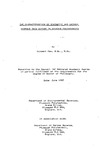THE CHARACTERISTICS OF SYNTHETIC AND NATURAL HYDROUS IRON OXIDES IN AQUEOUS ENVIRONMENTS
| dc.contributor.author | Man, Vincent | |
| dc.contributor.other | School of Geography, Earth and Environmental Sciences | en_US |
| dc.date.accessioned | 2011-09-27T08:58:27Z | |
| dc.date.available | 2011-09-27T08:58:27Z | |
| dc.date.issued | 1987 | |
| dc.identifier | Not available | en_US |
| dc.identifier.uri | http://hdl.handle.net/10026.1/736 | |
| dc.description | Merged with duplicate record 10026.1/2188 on 28.02.2017 by CS (TIS) | |
| dc.description.abstract |
The work in this thesis is concerned with the Green Rusts, which are bluegreen metastable Fe(II) - Fe(III) hydroxy compounds incorporating anions such as SO42-, Cl- or CO3-. These Green Rust compounds (or Fe-GR compounds to distinguish them from the aluminium Green Rusts (Al-GRs) which are isostructural Fe(II) - Al(III) hydroxy compounds) can be produced in a consistent fashion from Fe(II) solutions by the method of induced hydrolysis using Fe(III) gel at pH 7 and under anoxic conditions. A series of sulphate and chloride Fe-GR samples were synthesised, and characterised primarily by the analytical techniques of M8ssbauer spectroscopy, X-Ray diffractometry, infra-red spectroscopy, and vacuum microbalance to measure surface area using the BET N2 adsorption method. For comparison, a few samples of the analogous Al-GR compounds were also synthesised and characterised by the analytical techniques mentioned above. The results in this thesis showed that the systems producing the Fe-GR compounds were of a highly complex nature, and that the amount of precipitate formed depended crucially on the starting conditions. For the 0.1 M FeSO4 system, the GR formed was almost always accompanied by a goethite phase while, for the 0.1 M FeC12 system, pure GR material was only formed at initial Fe(II) - Fe(III) ratios (IFFRs) greater than 6. Any-differences between__the, sulphate and chloride Fe-GRs can. be attributed to the difference in anion-type. X-Ray diffraction in conjunction with electron microscopy and surface area measurements confirm-that the Fe-GRs have a pyroaurite crystal structure, with brucite-like layers formed by a matrix of Fe2+ and Fe 3+ cations and each layer bridged to the other by anions. As far as Messbauer spectroscopy is concerned, the most important diagnostic parameter is the quadrupole splitting (QS) of the Fe(II) doublet measured at 77K for the wet, fresh precipitate (i. e. frozen material). For sul phate Fe-GRs derived from 0.1 M FeSO4 the mean QS is 2.93 ± 0.05 mms-', while for the chloride Fe-GRs derived from 0.1 M FeC12 the mean QS is 2.80 ± 0.05 mms-1. Surface areas for the sulphate Fe-GRs are in the range 40-65 m2. g-1. The products of oxidation and ageing for the Fe-GRs indicate several transformation pathways, especially for the chloride Fe-GRs. Sulphate Fe-GRs converted to goethite on oxidation under both wet and dry conditions, while the chloride Fe-GRs converted to akaganeite on dry oxidation, and to lepidocrocite on wet oxidation. Under both wet and dry anoxic conditions, the chloride Fe-GRs converted to magnetite. In the case of the sulphate Fe-GRs, there was a suggestion that, under the right wet anoxic conditions, the material probably transformed into magnetite. These facts clearly demonstrate that the Fe-GRs are intermediaries in the thermodynamic transformation of Fe in the II oxidation state to Fe in the III oxidation state. | en_US |
| dc.language.iso | en | en_US |
| dc.publisher | University of Plymouth | en_US |
| dc.title | THE CHARACTERISTICS OF SYNTHETIC AND NATURAL HYDROUS IRON OXIDES IN AQUEOUS ENVIRONMENTS | en_US |
| dc.type | Thesis | |
| dc.identifier.doi | http://dx.doi.org/10.24382/3984 | |
| dc.identifier.doi | http://dx.doi.org/10.24382/3984 |
Files in this item
This item appears in the following Collection(s)
-
01 Research Theses Main Collection
Research Theses Main


